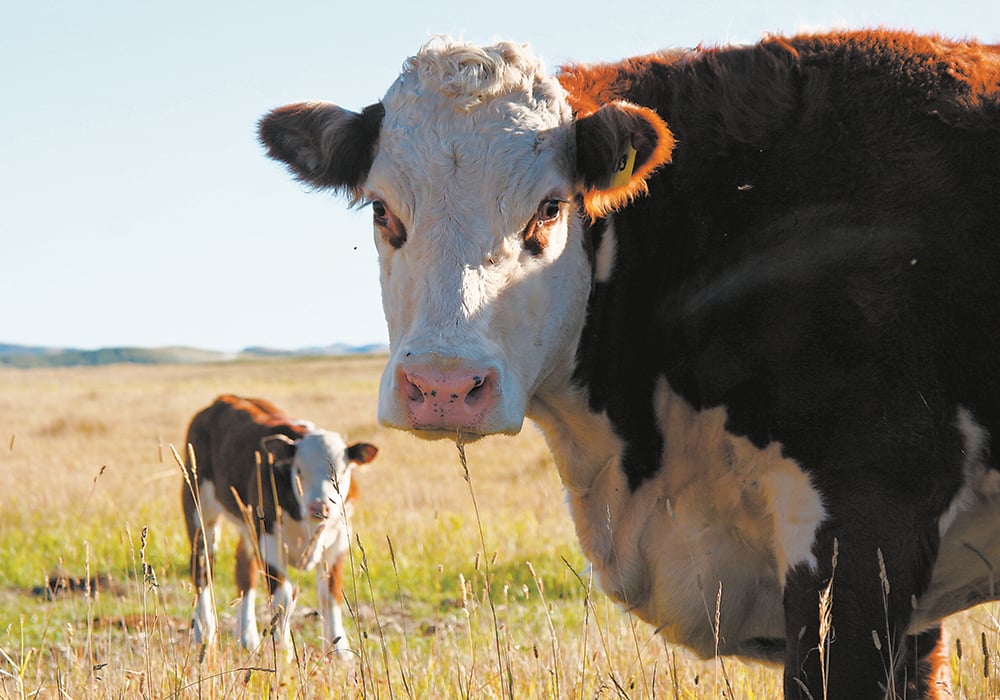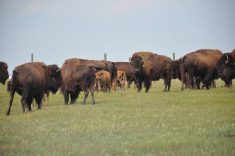Options that producers can use to make it a more low-stress experience include nose flaps and fence-line separation
Traditional weaning methods are traumatic for calves and cows but now there are better ways to wean besides rounding up the herd, sorting the calves and taking the cows away.
Calves are stressed when suddenly deprived of milk and mama at the same time, and the trauma of losing mom can be even harder than not having milk. Calves are very susceptible to illness at this time because stress hinders the immune system.
Bart Lardner at the University of Saskatchewan has been involved in studies of weaning.
Read Also

Trump’s tariffs take their toll on U.S. producers
U.S. farmers say Trump’s tariffs have been devastating for growers in that country.
“We did a small study several years ago to evaluate several weaning strategies, including fence-line weaning. We separated cows from calves, with a fence between them, where they could still get next to each other. We put a few dry cows with the calves to show them how to eat (and) we had the calves on millet swaths,” he said.
The calves did little bawling. They went out to graze and then returned to the fence to lie down near their mothers and chew their cuds.
“The cows on the other side of the fence, by contrast, were bawling. We realized that the cow misses the calf more than the calf misses the cow, until her full udder quits hurting,” said Lardner.
The calves were not stressed nutritionally because milk had been replaced with a good diet and proximity of the cows seemed to ease emotional stress.
“We need to reduce stress on calves because we want them to come off the milk diet and onto a forage diet gaining weight and not be vulnerable to illness,” said Lardner.
The least stressful weaning method is to leave the calves with the cows as they adjust to not having milk.
“We did some of the early studies on two-stage weaning with the nose flaps that Dr. Joe Stookey came up with, and that works very well,” Lardner said. “Calves are weaned by the time you take the nose flaps out a week later. Then you can separate them with no problems.”
However, not everyone is set up to handle calves twice: first to install the nose flaps and then to remove them. Fence-line weaning is an option in such cases.
Jon and Breezy Millar have a purebred Angus operation near Sturgis, South Dakota, and have been using fence-line weaning for 10 years.
“The summer of 2012 was dry and dusty, and our pastures were short. We knew we’d have to wean early, but it was so dusty I did not want to bring calves into a corral. So, we got set up to do fence-line weaning,” said Jon Millar.
“Now we keep one pasture ungrazed, as a weaning pasture. It’s tall but still green. We have two pastures side by side. Each one is about 800 acres divided by a barbed-wire fence, so we put a hot wire on each side of that fence. On the weaning pasture side, the hot wire is about nose high for a calf, and on the cow side we put it on top of the fence.”
Millar moves pairs into the weaning pasture about a week before sorting the calves off, so the calves get acquainted with the environment. For a few days before weaning, he puts out a little feed for both cows and calves.
“The cows know what it is and the calves remember from when we fed them earlier, so they all come. Then on the day we wean, we just pull the cows out (into the adjacent pasture) and leave the calves.
“It’s easy to move the cows. We drive in there with the feed wagon and the cows follow us,” Millar said.
“When we go back out through the gate, a couple riders on horses hold back the calves as the cows go through, following the feed wagon. Then we shut the gate and the sorting is done.
“With the hot wire, they don’t try to go through the fence. The cows actually throw a bigger fit than the calves. By the next day, about two-thirds of the calves are out grazing in the pasture or lying next to the fence, but for a couple days all the cows are pacing the fence.”
Millar said there has been no sickness using this method.
“Occasionally one or two calves have gotten through the fence to get with their mothers, but after we put them back in the weaning pasture, they don’t go through the fence again. They probably got shocked and don’t want to try it again.”
In about two weeks the calves are fully weaned and brought home.
“We tried to bring them home sooner than that, but it works best if we let them stay in that pasture a couple weeks,” said Millar. “The cows dry up before that and no longer worrying about the calves.”
The only thing missing for the calves is milk, he notes. Pairs can still be near each other through the fence.
“I’ve seen them bellow at each other and come walking to the fence. They stop and talk to each other and realize Mom (or baby) is still there and may just turn around and go off to graze, content.”
Millar said this weaning method requires a bit more management but he thinks it is worth it for the low stress and calf health.















